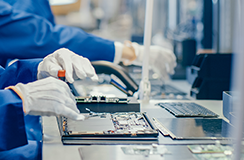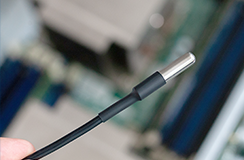- TOP
- Sustainability
- Action toward climate change
Action toward climate change
Action toward the TCFD
What is the Task Force on Climate-related Financial Disclosures (TCFD)?
The TCFD stands for the Task Force on Climate-related Financial Disclosures, which was established by the Financial Stability Board (FSB) in response to the request from G20 to discuss how to disclose the information related to climate. The TCFD released its final report in 2017 and recommended that companies should disclose four items regarding risks and opportunities related to climate change.
The Shibaura Electronics Group agrees with the intent of the TCFD and will take the appropriate action for developing the recommended system and disclosing the information related to the climate.

Governance
The Shibaura Electronics Group established the Sustainability Committee in November 2021 as an advisory body to the Board of Directors. This committee examines and promotes company-wide sustainability initiatives that include the response to climate change. The basic philosophies and important issues of climate change are discussed at the Sustainability Committee chaired by the president, and then are advised and recommended to the Board of Directors, by which the Group has built a governance system that allows appropriate supervision by the Board of Directors.
Governance System Diagram

Sustainability Committee
| Members | − Inside and outside directors and executive officers |
|---|---|
| Purpose | − To examine and promote company-wide sustainability initiatives |
| Activities | − Discussions and evaluation of sustainability initiatives at each base, and promotion of initiatives based on the Sustainability Basic Philosophy |
Strategy
To grasp the impact of climate change, the Shibaura Electronics Group conducted the assessment of its risks and opportunities using a scenario of temperature rise by 1.5 degrees C. The risks and opportunities were recognized as follows.
Risks
<Physical risk>
There is a risk that the operations and sales activities at the manufacturing bases of our Group may be affected by a disaster, such as a flood and typhoon.
<Transition risk>
There is a risk that the use of renewable energy may increase electricity charges.
It is thought that the tightening of environmental regulations by the government will increase the tax burden due to the introduction of carbon taxes in Japan, Thailand, and China where the group’s manufacturing bases are located.
<Cost simulation according to the scenario of a 1.5-degree Celsius increase estimated by our company>
| Increase in costs in 2030 (compared to 2021) | 760 million yen |
|---|
The scenario of a 1.5-degree Celsius increase is estimated, provided that our Group would reduce carbon dioxide emissions by 25% by 2030 compared to 2021. Besides, it is simulated that our sales would also increase to some extent. This scenario expects the increase in the cost of electricity charges due to electricity procurement based on renewable energy and the introduction of a carbon tax.
According to the Group’s plan for electricity procurement, our Group’s electricity charges procured with renewable energy are assumed to be higher than those procured with thermal power generation by approximately 5%. Thus, we estimated the cost increase would result in approximately 660 million yen.Regarding the carbon tax, our Group should pay approximately 100 million yen from the estimation based on carbon tax per ton CO2 (63 dollars in advanced countries and 43 dollars in developing countries), which was announced by the International Energy Agency (IEA).
As a result, the cost increase in 2030 by the scenario of a 1.5-degree Celsius increase is estimated to be approximately 760 million yen.
Opportunities
As the response to climate change spreads worldwide, it is anticipated that environmentally friendly vehicles, such as electric vehicles (EVs) and hybrid-electric vehicles (HEVs) will become more common than today and that demand for energy-saving home appliances will increase. It is considered that we will have an opportunity to increase the sales of our temperature sensors to be installed in those products.
We will announce tangible effects of such an opportunity on our sales and profits in our medium-term management plan.
Risk Management
The Shibaura Electronics Group recognizes various risks and opportunities associated with climate change as important issues in the business strategy. The Group has established a proper risk management system through the Sustainability Committee, which analyzes and assesses the risks and opportunities, and through the Board of Directors, which controls the Committee.
Indicators and Goals
The Shibaura Electronics Group formulated a long-term goal of reducing carbon dioxide emissions, aiming for carbon neutrality by 2050, to realize a decarbonized society. It strives to achieve its goals by saving electricity use and procuring electricity based on renewable energy.
| Indicators | 22,574 tons of carbon dioxide emissions in 2021 The total of direct emissions (Scope 1) and indirect emissions from energy sources (Scope 2) |
|---|---|
| Goals | To achieve zero carbon dioxide emissions by 2050 To reduce carbon dioxide emissions by 25% by 2030 compared to 2021 To reduce carbon dioxide emissions by 50% by 2040 compared to 2021 |








